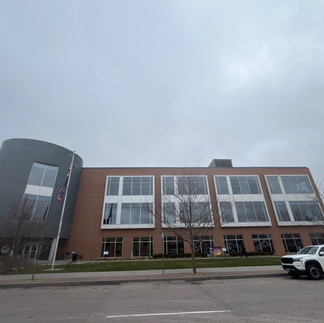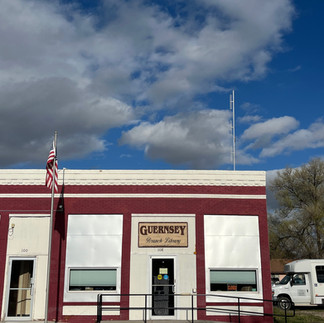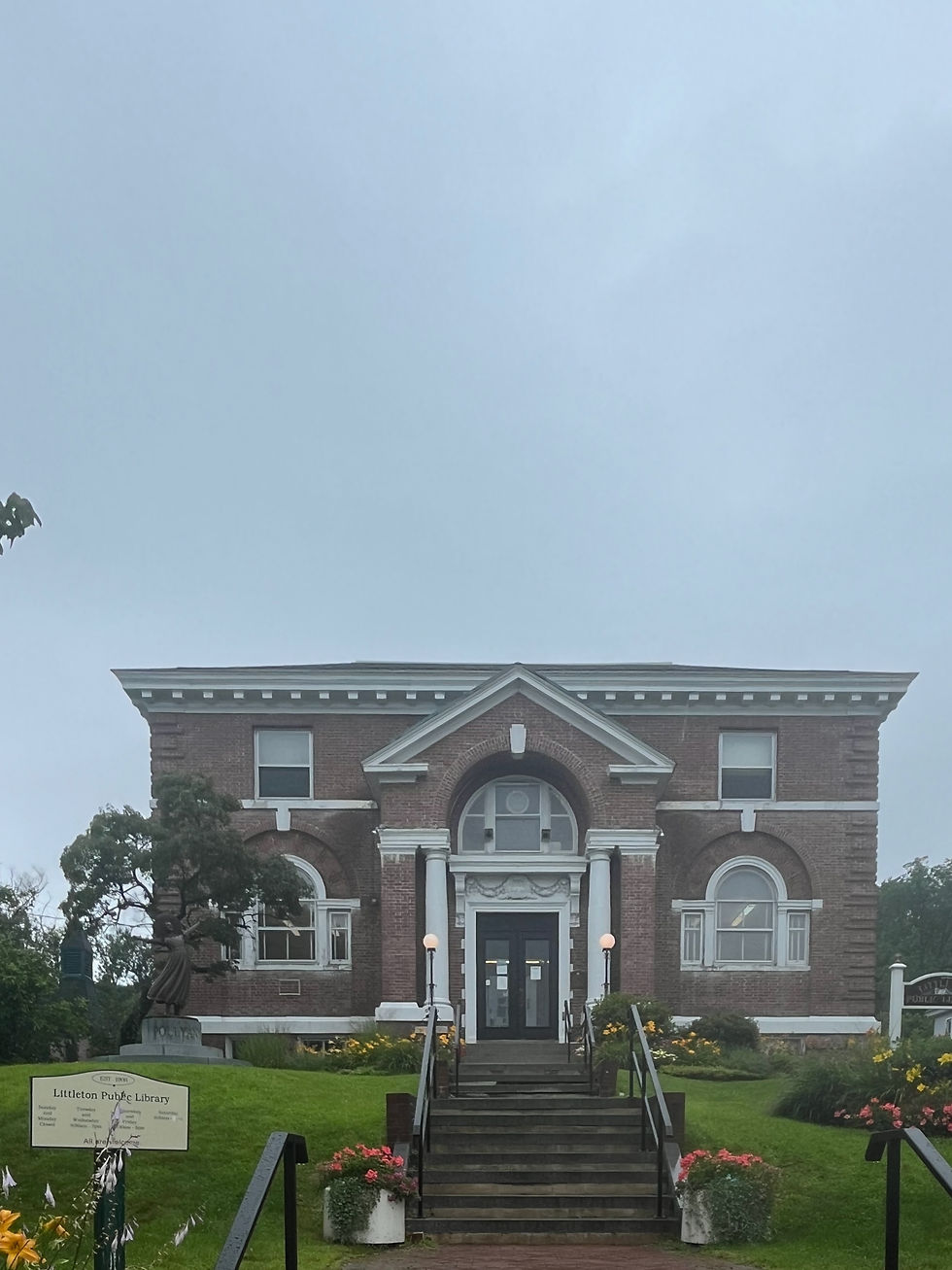Day 53, Saturday April 20, 2024: Golden, Colorado to Casper, Wyoming
- Mark Carl Rom
- Apr 24
- 9 min read
Carnegie libraries visited: Boulder, Wheatland, Lusk

Snow always thrills me; I never get tired of it. This may be because I have never had to struggle with it over a long winter. Growing up in Arkansas, we had maybe three or four good snow falls each winter, and every time we got more than an inch we also got a snow day holiday from school. Winters are extended in Wisconsin, where I went to graduate school, but I didn’t need to scrape my car every day (I rarely drove) or shovel the walk (I was probably supposed to do this, but I don’t remember doing so). Snow reminds me more of ski trips than of snow shovels.

I awoke to a winter wonderland in Golden, as maybe eight inches had fallen over night. The cars were covered, but the roads were clear. Speaking of buts, I realize I use them too much: they already appear 169 in this manuscript thus far. ‘But’ can be used for comedic purposes (see the Russian artist Anton Gudim’s “Yes, but” series) but (!!!) it is mainly used to negate what comes before it. (But I don’t mean to be negative!) I don’t want to give such a passive-aggressive meaning (“I love you, but I don’t love you”) so I guess I’ll have to rely on my copy-editor to clean them up no ifs, ands, and buts. As I was saying, Golden looked magnificent in the snow, especially from the vantage point of the recreation center’s hot tub.
I headed north around noon, taking pictures of a dozen libraries between Golden and Casper. The libraries ranged from the tiny ones in Chugwater and Guernsey, which were not much larger, if at all, than the one in Norman, Arkansas, to the hefty one in Cheyenne. (I couldn’t think of the right antonym for tiny to describe the one in Cheyenne, so I used Merriam-Webster thesaurus. As my niece Zoë puts it in her DNF podcast, “Writing is one percent inspiration, 99 percent perspiration, and ten percent looking words up in a thesaurus.”)
The one in Wheatland puzzled me most. I was looking for a Carnegie, and I had the right address, and the only building I saw was a modern brick building. The wikipedia listing for this Carnegie was color-coded to indicate that it was still in operation. I hadn’t read the listing closely enough: the original Carnegie was completely enclosed within the current one. No pictures of the original library are posted online, so if you happen to have one please drop me a line.
Seven of the sixteen Carnegie libraries built in Wyoming were demolished between 1954 and 1974, three of them before the National Historic Preservation Act of 1966 and three afterward. Only five of the sixteen continue their library services to their communities. Fortunately, Linda R. Waggener compiled a history of all the Wyoming Carnegies for her masters thesis. Here, briefly, are capsule accounts of a few of the demolished libraries, which can no longer be admired by those towns’ residents and visitors.
The Book Lovers’ Club, a women’s group, organized the first library in Basin in 1907. At the opening of the Carnegie library in 1910, a Mrs. W.C. Snow praised the town’s students who raised $65 for a stained glass window placed on the back wall of the library. When the library was demolished in 1954 – the first Wyoming Carnegie to be torn down – the window was salvaged and placed behind the circulation desk. A new library was built on the same site.
The Women’s Christian Temperance Union opened up a reading room in Casper in 1902, and the Public Library Association sought funding from Carnegie in 1905. The Casper Carnegie opened to the public in 1910, and it was demolished in 1970 after being expanded in 1954. A new library opened at the same location in 1974.
When the Cheyenne Carnegie library opened in 1902, it received a $500 gift to help furnish the Woman’s Club of Cheyenne room from Mrs. Andrew (Louise Whitfield) Carnegie, who had been a schoolmate of Mrs. William Sturgis, one of the town’s residents. Louise comes from the elite circles of the East (her family had emigrated from England in the 1600s, and the family’s home in Guilford, Connecticut, is one of the oldest houses in America, dating from 1639) and she spent the American part of her life in New York City. Mrs. Sturgis’ history is unknown, to me, anyway. What luck of the draw brought the two of them together? Cheyenne built a new library in 1969 and, lacking funds to renovate or repair the Carnegie library, it was razed in 1970.
The Cody Women’s Club founded its library in 1906. In February 1905, Frances M. Lane (as I read the signature), the Club’s Corresponding Secretary, wrote Mr. Carnegie on the Club’s own letterhead:
Dear Sir:
The Women’s Club of Cody, Wyoming, earnestly requests Mr. Carnegie to consider the town of Cody in his distribution of gifts of Free Public Library Buildings…on a lot we already hold for this purpose…[She then details the town and the area in all their promise.] The people here are educated, accustomed to using public libraries, and find books a necessity in their new life.
Trusting we may have your generous aid in our determination to establish a Free Public Library in Cody, I remain
Very Respectfully Yours,
Frances M. Lane

A town official followed up with a request that Carnegie a blank application form to Mrs. Henry M. Smith. The Carnegie archives do not show any response to these requests. In November 1912 Minnie Williams, the secretary of the Women’s Public Service League, made a similar request on behalf of the League.
A word on the League. The Club was organized two years ago soon after Cody appeared on the map, belongs to the Federation and solely through its efforts a stone building 25 [by] 40 was erected and equipped which has always been maintained by these women. We now feel to meet present needs it should be larger and have more books…Kindly give particulars that it may be reported at some future meeting.
More letters of support follow, including one from a Presbyterian minister who notes that “The Ladies of this town have struggled nobly to maintain a Public Library, but have come to the point where it is too difficult for them to do so with the efficiency commensurate with the needs of this widely scattered community.” Another letter in 1914 refers to the work of the Women’s Club of Cody.
Bertram responds “[B]ut in one sentence you ask for a library and at the same time state that you have already built and equipped a small, stone library building. Why should it be superseded?” The response was that the library had been opened ten years prior, when the town was in its infancy, and that the building is an “ugly, architectural ‘eyesore’ situated right on the spot where a fine looking building ought to be.”
The usual back and forth proceeds, with Bertram’s letters addressed to Dr. Frances M. Lane, Chairman, Park County Library Board. In them, Bertram often sounds peeved. “Why have you not followed the Notes on the Erection of Library Buildings which were sent to you with the promise?” Lane continues to revise her requests to meet Bertram’s demands, including one telegram to him. (His reply: “I regret that we cannot conduct library correspondence by telegram…we are still without satisfactory plans…”)
Finally, Lane wrote Bertram in December 1914 “I believe we have complied with all requirements.” Bertram is not convinced “You had better read over the memorandum carefully.” Lane goes back to the drawing board and revises. On March 15, 1915, Bertram announced that “arrangements have been made for payments as the work progresses.” Throughout their correspondence, Bertram wrote Dr. Lane as “Dear Sir.” She was not, in fact, a Sir and no, indeed, she didn’t correct him. Given her honorific title of Dr., her androgynous first name Frances, and the state of society, his confusion is as understandable as her unwillingness to correct him. Dr. Lane, it might also be noted, served as the Chairman of the Wyoming Branch of the National Women's Party, which broke away from the National American Woman Suffrage Association. The NAWSA sought to gain voting rights for women at the state level, while the NWP believed that a constitutional amendment was necessary to grant women the right to vote everywhere.
The Cody Carnegie library opened 1916, with Mabel Wilkinson its first librarian. Just a year short of its 50th anniversary, it was leveled, to be replaced by a new library on the same spot.
The Douglas Library Association was responsible for the establishment of the first library in that town, in 1905, and its first librarian was Miss Maggie Ferguson. Its Carnegie library opened in 1911 and it was demolished in 1966 and a new library was built on the same spot. Women were not influential in the history of the library in Sheridan. It was built in 1905 and destroyed in 1974, with its location used for a parking lot for the new library.
Lusk is the county seat of the most rural county of the most rural state. Its first library was the Stillman Public Library, named after Mrs. Sarah Stillman, the great grandmother of the founder of Lusk, on her 100th birthday. That Lusk had a library was noted by Mrs. J. (?) E. Goddard, Secretary of the Lusk Reading Club, in her letter to Carnegie in November 1913 “A year and a half ago, the Women’s Club established a library here and it has been a great success. We have over 500 volumes, 216 card holders, [and] a good daily attendance…”
Following up, in February 1914 Mrs. Henry T. Gray, the President of the Club, “Will you kindly permit me to add a few words…by more fully explaining the situation and our needs?...Mrs. Stillman was a grand type of a splendid woman, but she left no money.”
Secretary Bertram, busy as always and perhaps distracted, responds that “Yours of February 23 was received, but we find no Niobara County in the 1910 census.” Mrs. Gray had merely mentioned that the Stillman library was now part of the “(now) County Public Library. In a subsequent letter, the County Clerk clarified that a Niobara County did, in fact, exist.
Henceforth, Mrs. Gray wrote letters on the letterhead of her husband, a member of the state’s legislature, while crossing out his name. She wrote that it was on the encouragement of these “men of the highest standing and unquestioned integrity” that she undertook the task of corresponding with Bertram, ending the letter with “Hoping I have not grown tiresome.”
It’s not clear what happened next. In Gray’s next letter, on July 8, 1914 – there is no response from Bertram to Gray’s previous letter in the files – she writes
I find myself in an almost ridiculous position. I cannot express my regret and disappointment. It goes without saying that I did not foresee such a situation or the final outcome would have looked more promising. When I sent you the first application last February it said “Seven hundred more books promised, Site secured, One thousand dollars raised. Now, without exception, these promises were not held…
It seems that the Chairman of the County Commissioners was or is under some political obligation by a Mr. Goddard here and has promised to reappoint his wife a member of the library board. There was an all around [illegible] of disapproval. The other two members of the board resigned on her account and to make matters worse it would hardly have been possible to secure two weaker members than those put in her place. None of the best people in town would accept unless she was removed. Immediately the pledges towards our new library were removed.
She continues this account for several more paragraphs before stating that, “I am sure you will understand that I should not prefer not to be drawn into this in a public way” and that, should Bertram wish to continue discussions, he should contact other local officials.
In fact, Gray could not keep out of it. In February 1917 she again wrote Bertram asking if the library promised in 1914 was still available and, if it was not, could he send her an application so she could reapply. Bertram responded that the promise that had been made three years ago had been neglected and that, should the town still want a library, the request must come from town officials. Mrs. Gray, persisting, writes back that she will pass this information to the County Commissioners who will, “no doubt take action.” When the Commissioners did write, Bertram scolds them that “the enclosed pledge does not meet requirements.
The letters continue to flow back and forth. Gray was not the only woman to write: letters also come from Miss Minnie Galbraith, the Secretary of the Civic Improvement Club; Mrs. Florence Goddard, the President of the Library Board; and Mrs. [illegible] Rogers, the President of the Civic Improvement Club. Gray again intervenes: “[I]f there is anything I can do to clear up this troubled situation I shall be glad to act for a while at least.”
Bertram’s frustration is palpable: “You will realize that it is impossible for me to correspond with three different people [a Mr. Jones, Miss Galbraith, and Miss Grace Hebard, whose letter I have not seen] about one library project.” By this time, as you might expect, the costs for the library had risen and so the principals haggled over the price. Finally (finally!) the Carnegie grant was approved in September 1918, fully five years after the initial request.

I’ll confess that even reading all the correspondence was exhausting. My sympathy goes to Bertram, who was dealing with thousands of requests for grants. I can’t blame him for being brusque, peeved, and frustrated, and yet also carefully stewarding Carnegie’s fortune. I’m also impressed with the women (and men) who persisted, however disorganized, to obtain the library of their dreams.
Sidenote: Lusk, Ireland, also has a Carnegie Library.
Endnote: Lusk has the only known monument to a person identified as a sex worker. Charlotte Shepard, better known as Mother Featherlegs because of the ruffled lace underwear she wore, was murdered in 1879. Her establishment offered whiskey, gambling, and sex. All required cash payments.



























Comments